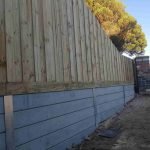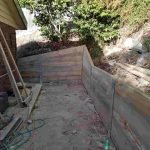Introduction
When it comes to landscaping and structural integrity, retaining walls play an essential role. These crafted structures not just serve the practical purpose of avoiding soil erosion however likewise include retaining walls installation https://tuffstuffretainingwalls.com.au/ visual value to your home. Whether you're seeking to boost the charm of your garden or need a functional service for uneven surface, comprehending the nuances of retaining wall builders is necessary. Our goal here is to check out the multifaceted world of retaining wall construction, focusing on products such as timber sleeper, concrete sleeper, and H-beam techniques employed by specialists in the field.
Retaining Wall Builders: Crafting Stability and Beauty
Building a retaining wall is no small accomplishment; it needs mindful preparation, professional knowledge, and an eye for style. Retaining wall home builders are skilled artisans who comprehend the science behind stability while ensuring that beauty isn't jeopardized. They work carefully to pick the ideal products and techniques customized to satisfy each special requirement.
Why Pick Professional Retaining Wall Builders?
The concern arises: why should you think about employing professional retaining wall builders instead of handling the job yourself?
- Expertise: Professionals have extensive training and experience in building resilient maintaining walls. Safety: An inadequately built wall can result in devastating failures. Professionals guarantee that walls are safe and certified with local regulations. Aesthetics: Knowledgeable home builders understand how to incorporate walls into the landscape perfectly, enhancing your home's visual appeal.
Understanding Different Types of Maintaining Walls
1. Gravity Walls
Gravity walls rely on their weight to withstand lateral earth pressure. These walls can be made from various materials consisting of stone or concrete.
Advantages of Gravity Walls
- Simple design Cost-effective Naturally blends with landscape
2. Cantilevered Walls
Cantilevered walls utilize leverage; they are generally made from enhanced concrete and have a thick base that extends back into the soil.
Benefits of Cantilevered Walls
- Economical for taller structures Efficient use of material Can manage substantial loads
3. Anchored Walls
Anchored keeping walls are protected by anchors that extend into stable soil or rock behind them.
Pros of Anchored Walls
- Suitable for high slopes Added stability without big masses Flexible design options
Key Products Used by Retaining Wall Builders
Timber Sleeper Retaining Walls
Timber sleepers have actually ended up being significantly popular due to their natural appearance and ease of installation.
Characteristics of Wood Sleepers
- Environmentally friendly Versatile in design Cost-effective compared to other materials
Considerations: While timber provides numerous benefits, it's essential to pick treated wood resistant to rot and pests.
Concrete Sleeper Retaining Walls
Concrete sleepers offer a robust alternative understood for their durability.
Features of Concrete Sleepers
- High strength-to-weight ratio Minimal maintenance required Resistant to weather conditions
Installation Tips: Proper drain behind the wall is vital to prevent water build-up which could weaken its stability.
H-Beam Maintaining Walls
H-beams provide extraordinary support thanks to their shape which allows them to distribute weight evenly.

Advantages of H-Beams
- Superior load-bearing capacity Durable versus environmental elements Quick installation process
Usage: Typically used in industrial applications due to their reliability and strength.
The Design Process for Keeping Walls
Site Assessment
Before any building begins, a thorough site evaluation must be performed. This involves examining:
Soil type Drainage patterns Existing vegetationPlanning & Design Phase
Once assessed, it's time for style-- this includes determining:
The height and length of the wall. Material selection (timber sleeper vs concrete sleeper). Aesthetic considerations.Construction Methods Used by Professionals
Excavation & Preparation
The primary step in constructing a retaining wall is excavation-- guaranteeing that you have firm ground upon which your wall will sit is critical.
Remove topsoil. Level out the area appropriately. Create drainage channels if necessary.Foundation Work
A strong foundation warranties stability:
Lay down gravel for drainage. Set up formwork if utilizing concrete. For lumber sleepers, establish anchor points in the ground.Installation Steps for Different Types of Materials
Installing Timber Sleeper Walls
Measure and cut sleepers according to your design. Position them vertically or horizontally based upon aesthetics. Secure them utilizing stakes or brackets for added strength.Installing Concrete Sleeper Walls
Mix concrete according to specifications. Pour concrete into types established during foundation work. Allow appropriate curing time before applying additional layers or finishes.Installing H-Beam Walls
Drive H-beams into pre-dug holes at specified intervals. Backfill around beams while keeping level alignment. Use additional assistances if needed during building phases.Drainage Solutions for Keeping Walls
Proper drainage is critical when developing any kind of retaining wall as it assists avoid hydrostatic pressure accumulation which can lead to failure over time.
Why Is Drain Important?
Hydrostatic pressure can weaken your structure leading it potentially collapsing under excess water weight; hence:
Incorporate weep holes during construction. Use drain pipelines behind the wall directing water away from structure areas. Ensure correct grading around the base so water streams away from your structure effectively.
Maintenance Tips for Long-lasting Retaining Walls
To keep your retaining walls looking great while functioning correctly:
Regularly check for fractures or bulging indications indicating failure. Clean debris from weep holes periodically. Reapply treatments (for lumber) every couple of years as necessary depending upon direct exposure conditions.FAQs about Retaining Wall Builders
Q1: Can I construct my own maintaining wall?
A: Yes, you can construct one yourself; however, employing experts ensures safety and compliance with regional guidelines while providing know-how in style and product selection.
Q2: For how long do timber sleeper walls last?
A: Treated timber sleeper walls can last anywhere from 15-- thirty years depending upon ecological conditions and upkeep practices adopted over time.
Q3: What's more cost-effective - lumber or concrete sleepers?
A: Wood sleepers tend to be less costly upfront than concrete; nevertheless, think about long-term maintenance costs when making your decision.

Q4: Do I need a license for my maintaining wall?
A: Depending on regional policies relating to building and construction tasks, licenses might be required especially if exceeding particular heights; always contact regional authorities.
Q5: Exist particular designs available?
A: Definitely! There are various styles ranging from rustic lumber aesthetic appeals through streamlined contemporary styles featuring stone or brick finishes-- speaking with specialists often yields customized solutions.
Q6: How do I understand what material is best suited?
A: Elements such as budget plan restraints, desired aesthetic appeals, height requirements in addition to ecological considerations all contribute towards picking ideal products-- speaking with experts can considerably help this decision-making process!
Conclusion
In conclusion, building a robust yet gorgeous retaining wall is a venture that is worthy of attention covering both artistry along with engineering expertise-- retaining wall builders embody this balance expertly! Whether opting for timber sleeper solutions providing natural appeal or going robust with concrete sleep alternatives alongside sophisticated methods like H-beams; engaging educated professionals makes sure success throughout all phases-- from preliminary preparation through continuous maintenance strategies!
With this extensive guide covering different elements associated with developing amazingly stable landscape features we hope you feel much better equipped moving on! Embrace these insights provided here today-- your outside space will thank you later!